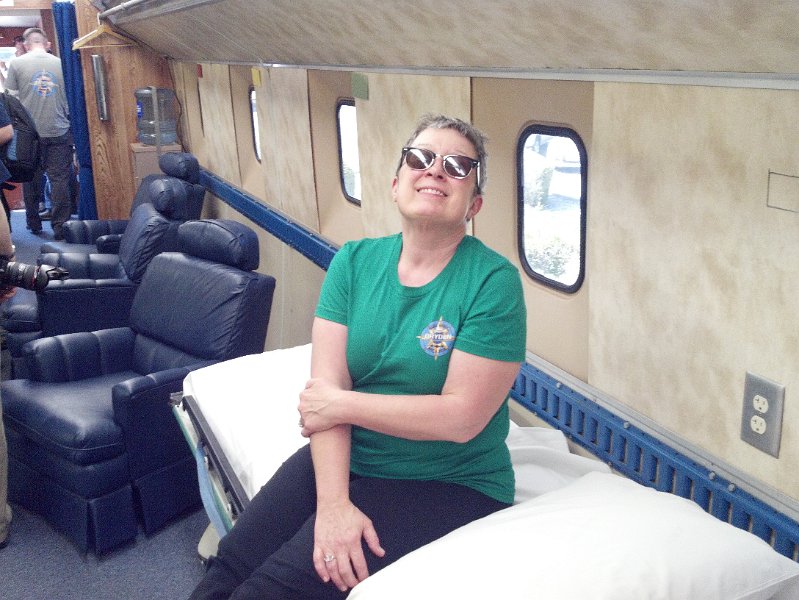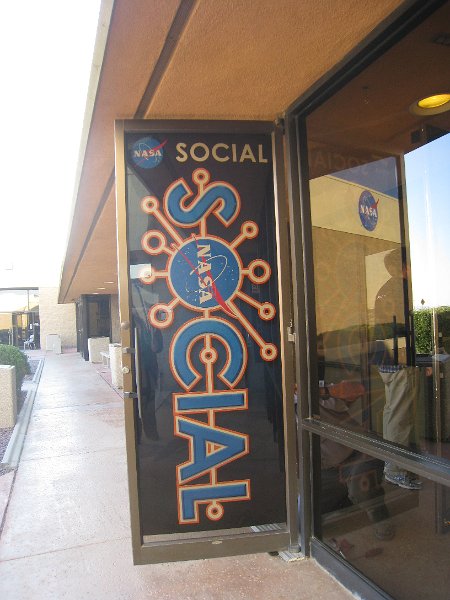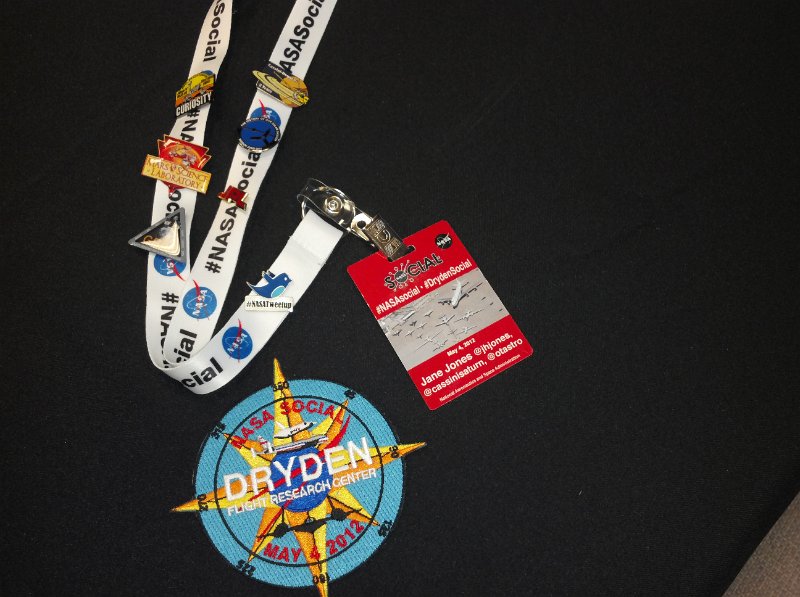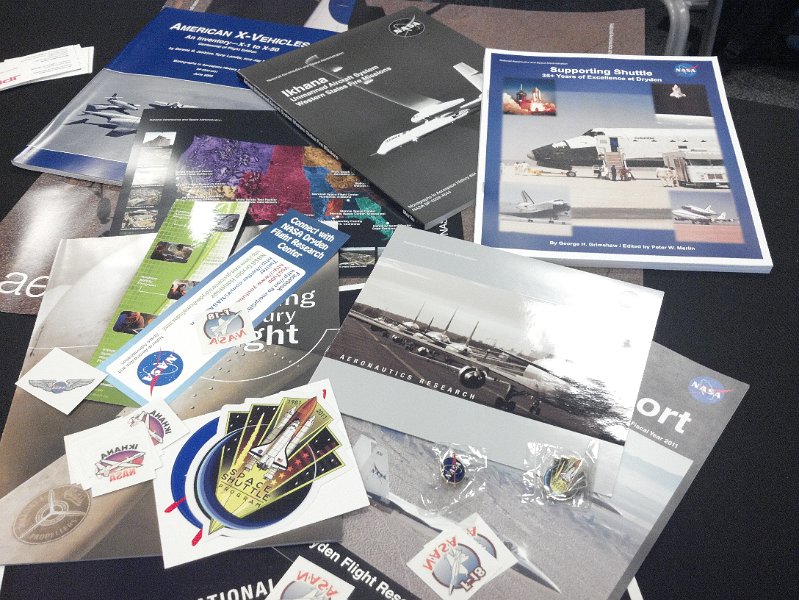
Here I am inside the Astronaut CTV (Crew Transport Vehicle) I would have laid down on the bed I'm sitting on, but I was too excited!
I was one of the lucky attendees at the first NASA Social at Dryden Flight Research Center last Friday, May 4, 2012. Here’s my first blog about the event — a play-by-play rundown of the speakers and tours on the agenda. NASA selects attendees who use social media, so naturally we’re encouraged to share the experience. Who wouldn’t want to do that, anyway? Here’s my social self for you to follow if you’d like: @jhjones on Twitter and JaneHoustonJones on Facebook. My NASA video podcast, What’s Up, with RSS feed and iTunes link is here, on YouTube here, and expanded with educational activites, starcharts and web links here.
But, first of all, I’d like to offer my sincere thanks to the Dryden Office of Strategic Communications team for a flawless and exhilarating experience! Thank you Kevin, Lisa, Terry, Beth, Leslie, and the many others who put this event together. Thanks to the speakers, the pilots, and the many interpreters, managers, AV team, oh, gosh thanks everyone at the Dryden Flight Research Center for allowing 50 Aeronautical geeks/social media savants into your world for a day. We really appreciated it!
In looking over the agenda, I noticed a url below every single speaker’s name and most of the aircraft and other venues we visited. What a brilliant addition to the program!
Introductions
Kevin Rohrer, Chief of the Office of Strategic Communications Kevin’s Bio
Stuff I learned: Kevin makes his own beer, and drinks it too!
Welcome
David McBride, Center Director David’s bio
Stuff I learned: Dryden has the most manned launches of ANY @NASA center! And David watches my What’s Up podcast via itunes on his iPad.
History of Dryden Flight Research Center
Christian Gelzer, Chief Historian About Dryden Stuff I learned: Dryden started in 1946 to test the X-1 and find out if supersonic flight was possible (and survivable).
Sonic Booms
Ed Haering, NASA Aerospace Engineer
Sonic Booms
Dryden sonic boom research Stuff I learned: “The boom you heard today started in 1947. You look out on the lake bed and realize how blessed you are to be doing this.”
Historical aircraft tour
Pete Merlin, Dryden Historian
X-1E
LLRV-Lunar Landing Research Vehicle Stuff I learned: The LLRV was used to study and analyze piloting techniques needed to fly and land the Apollo Lunar Module in the moon’s airless environment
M2-F1 lifting body I learned: M=Manned, F= Flight. The wingless, lifting body aircraft design was initially conceived as a means of landing an aircraft horizontally after atmospheric reentry.
Global Hawk (unmanned)
Phil Hill, NOAA Pilot
Global Hawk Learned: is an unmanned aircraft for high-altitude, long-duration Earth science missions. 111,000 nautical mile range, 30-hour endurance.
Ikhana (Predator B unmanned)
Hernan Posada, Mark Pestana
Ikhana – unmanned science demonstration aircraft. I learned Mark Pestana’s daughter is an intern at JPL, in fact, I’m meeting her tomorrow I met her two days ago and took her on a tour of JPL’s Space Flight Operations Facility “Darkroom”. And I learned Ikhana is a Choctaw Native American word for “intelligent, conscious, or aware, and this drone is used to conduct long-duration Earth observations. One more thing I learned: Mark Designs NASA Mission Patches in his spare time!
Gulfstream- III
Ethan Baumann and Natalie Spivey, NASA Engineers
Gulfstream-III Learned – it’s a multi-role cooperative research platform testbed for a variety of flight research experiments.
Dryden Pilots
Nils Larson, Acting Chief pilot Nils’ bio
Stuff I heard: Great quotes on working at Dryden: “”You look out at the lakebed and you think ‘It’s so cool’…It’s like being paid to eat ice cream.” “U-2 most difficult plane to fly, F/A-18 most fun, F-15 is the Cadillac” Why did you choose @nasaDryden? “Dryden is Mecca for test pilots” “flew between 90 & 100 different planes, blimps, etc. U2 is fun to fly because it can have bad day!”
Link to all Dryden Pilots (warning, includes many astronauts who worked here at Dryden.)
Lunch Break in the Dryden cafe – I had chicken salad with pilots in flight suits! @Camilla_SDO seated (perched) at the next table, gave me the stink-eye >.<
Automatic Collision Avoidance Technology
Mark Skoog, Project Manager
Automatic Collision Avoidance Technology Link to awesome avoidance vids posted soon. I learned to follow the lunch break with collision avoidance videos. Wow!
Flight Opportunities Program
John Kelly, NASA Program Manager
3 min Flight Opportunities vid Stuff I learned: Flight Opportunities system has tested orbital emergency surgery techniques and fire extinguishers prior to use on ISS, helping private companies test in more space-like environs, gets suborbital flights for payloads needing to fly in 0g, stuff like that.
Experimental Fabrication Lab
Ed Swan, Structural Fabrication Branch Chief
Experimental Fabrication Labs What I learned: Best quips of the day. “No aircraft flies here without something pointy sticking out of it.” and “What was your most interesting job?” / “Cutting a four-engine airplane in half.” “@NASADryden understands that parts need to be perfect, they give us our time. Parts can be worth millions in data. Best Quote: “You have a whole project waiting on the part, you don’t have time to tweet”. Here’s another Fabrication Lab feature.
Life Support
Phillip Wellner, Aircrew Life Support Technician
Dryden Aircrew Life Support Systems Stuff I learned: If a pilot flew above the Armstrong limit using only an oxygen mask and no pressure suit, the water wetting his lungs would boil as would the saliva in his mouth. Blood would boil too.
Stuff I watched: Phillip inflated a SR-71 flight suit with a shop vac, High-altitude flight suit fashion show, Helmet foo. Stuff I ate: high altitude Chicken a la king, Sloppy Joes, applesauce in a silvery toothpaste-ish tube.
Flight Load Labs
Larry Hudson, Chief Test Supervisor
Flight Loads Lab What I learned: Watched a plane flap its wings during flight load testing in fast motion. Large quartz lamps apply radiant energy to test airframes to simulate heat in flight. Flight Loads Lab tests not only structural loads, but heat and environmental loads, too!
Photography
Jim Ross, Multimedia Supervisor
Jim Ross link. Stuff I learned: Astronaut Gordon Fullerton, retired, former Chief Pilot at Dryden is mentioned in nearly every presentation. He referred to Jim Ross (and other video/photog staff) as “self loading baggage” with a wink, I bet. (I tweeted that!) Bonus: We all got autographed shuttle/747 picture by Jim (#NASA904 and #OV103).
Videography
Lori Losey, Senior Video Producer/Director
Here’s the video we saw. Lori Losey award writeup. What I learned: Awesome presentation, more great quotes from Lori: I have the best seat in the house. “You can Puke in a bag at 3G’s. You tie it off, put it in your suit, and keep filming.” “Compressed my spine, dislocated my shoulder, bruises from harnesses.”
Hangar 4802 (Aircraft tour and F-18 cockpit photos)
F-18 Hornet aircraft It was an FA-18 flyover test with a sonic boom for the @DrydenSocial!
Crew Transportation Vehicle Learned: Seven seats (and a few beds) for seven Shuttle astronauts in the Crew Transport Vehicle.
YO-3 Only 11 YO-3′s built in the Vietnam era and this is the only remaining functional one. Used for baseline sound tests (it’s very quiet) YO-3A propeller: 78 layers of birch.
T-34 At Dryden, the T-34C is primarily used for chasing remotely piloted unmanned air vehicles which fly slower than NASA’s F-18′s mission support aircraft can fly. It is also used for required pilot proficiency flying.
T-48 This is the 1st time the public has been allowed to see the X-48C Hybrid Wing Body.
Gulfstream II NASA 944, one of four Gulfstream II Shuttle Training Aircraft, arrived at NASA’s Dryden Flight Research Center from the Johnson Space Center in Houston Aug. 19 in preparation for its retirement and eventual static display.
Beechcraft Kingair One of Dryden’s King Air aircraft, NASA 801, (N801NA) serves as a testbed for various research projects, and is also flown for a range of mission support activities.
Media and blog links
May 1, 2012 feature Behind the Scenes @NASADryden
May 7, 2012 feature NASA Social: Behind the Scenes at Dryden
See what the #DrydenSocial attendees tweeted here!
Flying through the Leonid Storm of 2002, aboard NASA Dryden’s DC-8 Airborne Research Laboratory with Astronaut Gordon Fullerton as our pilot. Lots of interior DC-8 photos of our scientific equipment, too.




Hi Jane,
Glad to see you got on the Dryden Tweetup.
FYI, You met Gordon Fullerton on the 2002 Flight.
http://www.whiteoaks.com/mac-2002/1024/DSCN2752.JPG
I would have loved to join you at Dryden but I got busy on something else:
http://www.space.com/15555-meteorite-fireball-airship-search.html
Domingo’s Rocks!
Thanks for sharing.
Later,
Mike
Thanks, Mike! We have pictures of Gordon Fullerton in the 2002 Leonid/DC8 photo album and in my writeups. He was also Chief Test Pilot at Dryden!
Great Blog Jane! We did all that in a day?!?!?!? and people had time to tweet, blog and post to Facebook ?!?!?!? No wonder I was tired when I got home that evening. It was so much fun hosting you and the social crew, I can’t wait until we get to do it again.
Thanks Kevin, I think I am finally recovered – loved the FTP server and galley proofs, very professional way to share huge amount of image data. The group shot and F/18 are by FB images at the moment.